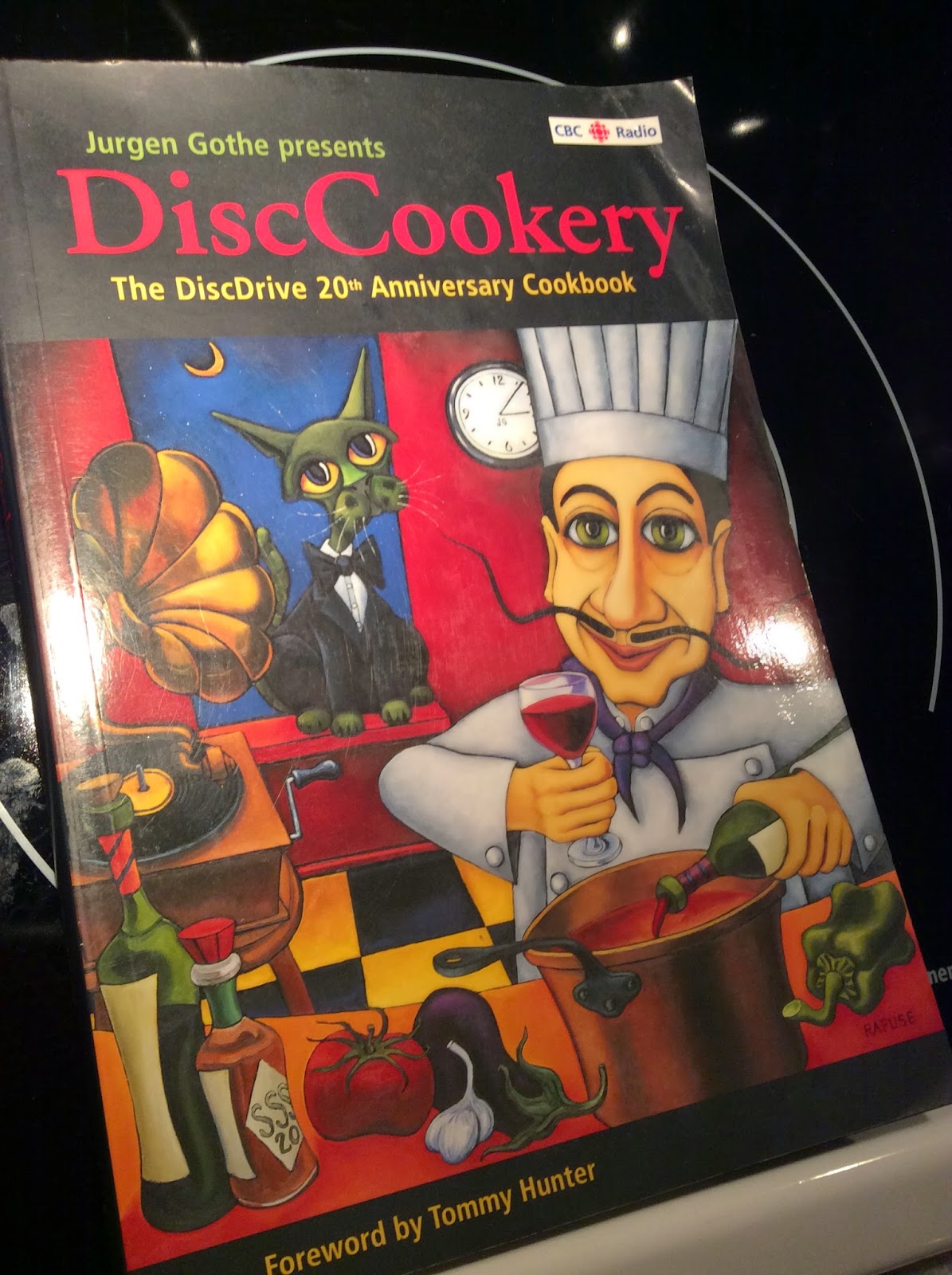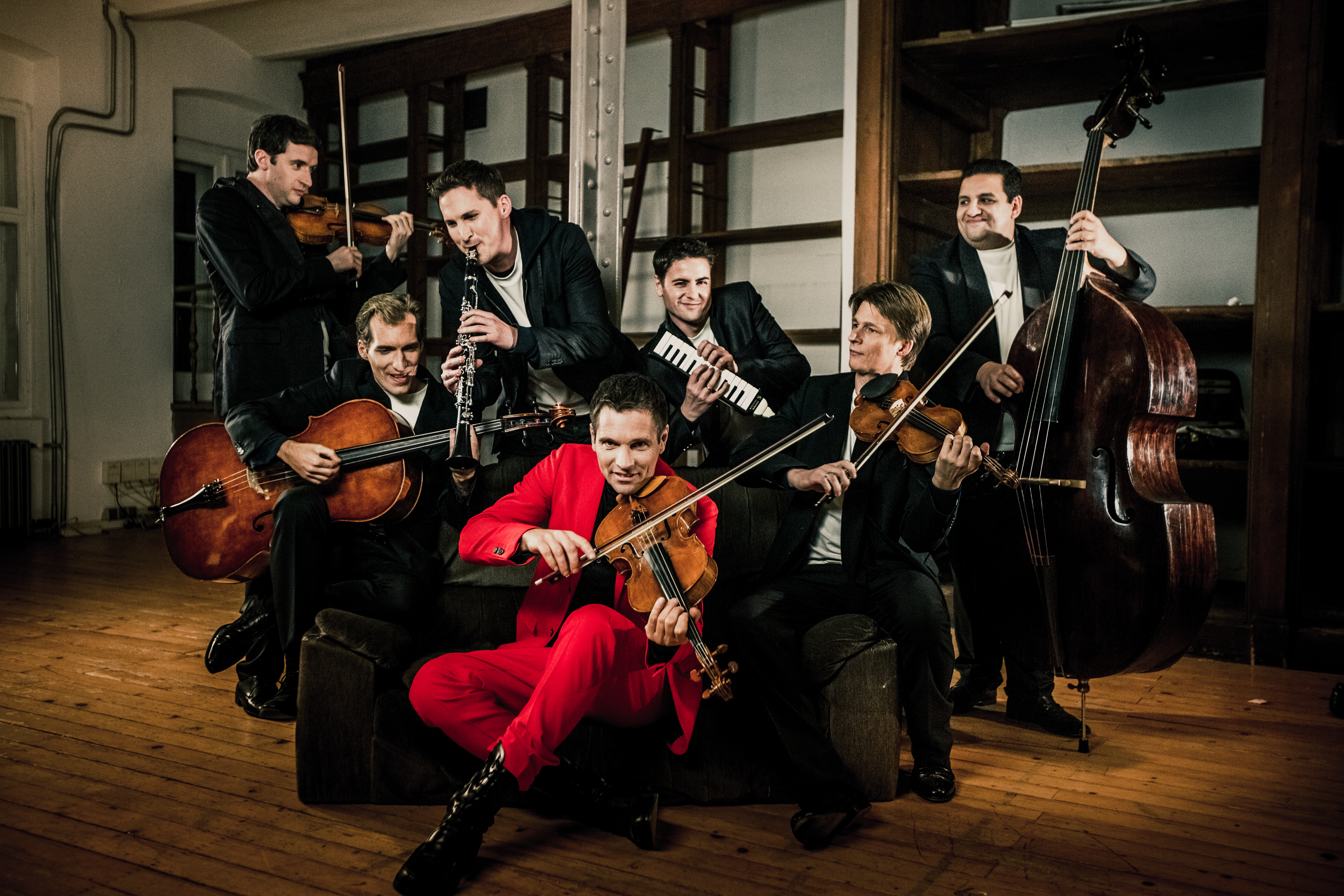
Photo: Max Parovsky
There’s really no such thing as a side-project for those who work in the arts; there are only many different aspects of one’s creative self that manifest in various ways, creating an ever-evolving tapestry of expression and experience.
This seems especially true for Philharmonix, a collective made up of members of the Berlin Philharmonic (violinist Noah Bendix-Balgley and cellist Stephan Koncz), the Vienna Philharmonic (bassist Ödön Rácz, clarinetist Daniel Ottensamer, violist Thilo Fechner), pianist Christoph Traxler (who’s performed with the Vienna Chamber Orchestra and the Staatskapelle Halle), and violinist/vocalist Sebastian Gürtler (first Concertmaster of the Wiener Volksoper from 1997 to 2008). One could easily label their efforts “gateway” – but I’m not sure classical music, when done well and presented with so much class and intelligence, requires any real “gateways.” If one is curious, open, broad-minded, and leaves preconceptions at the door, the wonders of the classical world tend to unfurl on their own, no gateways needed. There’s no denying a satisfying integration of entertainment, education, creativity, and chemistry greatly helps, and it’s here that Philharmonix excels. Their 2018 album, The Vienna Berlin Music Club Volume 1 (Deutsche Grammophon), is an eclectic mix of Central and Eastern European sounds, and happily raises a glass to the past while dancing firmly into the future, encouraging audiences to do the same. By turns playful, smart, and brimming with curiosity, it’s a musical fusion for dreaming, and dancing, for cooking, for cleaning, for primping and plying, for smiling, for silence, for living: “l’chaim,” “willkommen,” “rock on,” and “excelsior,” it seems to say, in so many tones and textures and tempi.
Mental workouts are sewn into the colorful quilts of their creative arrangements; one hears so many, many different sounds from moment to moment. Henry Mancini’s “Baby Elephant Walk” merges playfully with his theme from Peter Gunn; a classy, creative take on Queen’s “Bohemian Rhapsody” has snatches of “Ava Maria”; their thoughtful “Russian Overture” moves from stately seriousness (with vocals) to a Klezmer-like explosion of energy that references portions of The Nutcracker and Khachaturian’s Sabre Dance. A charming rendition of “Felix Navidad”, with pizzicato strings, breezy piano, and buzzy percussion offers a lovely respite in an album of intense energy and verve; “Englishman in New York” blends Klezmer, scat, and classical chamber sounds. Then there’s the gorgeous (and for me, wildly familiar) sounds of gypsy in “Gnossienne” and “Balkan Party” – this is the music of my own childhood and cultural background, and I admit to being slightly greedy in the sonic sense of wanting more of it; perhaps their next album (The Vienna Berlin Music Club Volume 2, releasing September 27th through Deutsche Grammophon) will serve that fix, along with a panoply of other delicious sounds.
What makes Philharmonix special is that they provide not only a valuable perspective to what each member does in their respective day jobs (and it’s worth looking into those, because it changes how you perceive their work in important ways) but a very smart way to listen to past and present; you hear classical works differently after spending time really listening to what they do. This is one side project that doesn’t really feel like (much less sound like) a side project at all; its members sound as if they’ve known one another for decades, playing in one another’s living rooms, at one another’s graduations and weddings and bar mitzvahs, in bars and cars and trains and planes. Their curiosity feels much larger than a concert hall, but at the same time their musical understanding is more intimate than the coziest parlour.
That ease and familiarity was underlined in my conversation this past summer with two Philharmonix members. Noah Bendix-Balgley, First Concertmaster of the Berliner Philharmoniker since 2014, and Stephan Koncz, Cello with the Berliner Philharmoniker since 2010, when they were between Philharnonix gigs in rural Austria. While lively and conversational, the pair were were equally blunt in sharing their thoughts on the role this project has playing in influencing the work they do with the Berlin Phil, and vice-versa. The band plays the Wiener Konzerthaus the end of this month, with performances in Dresden, Luxembourg and the U.K. in December.
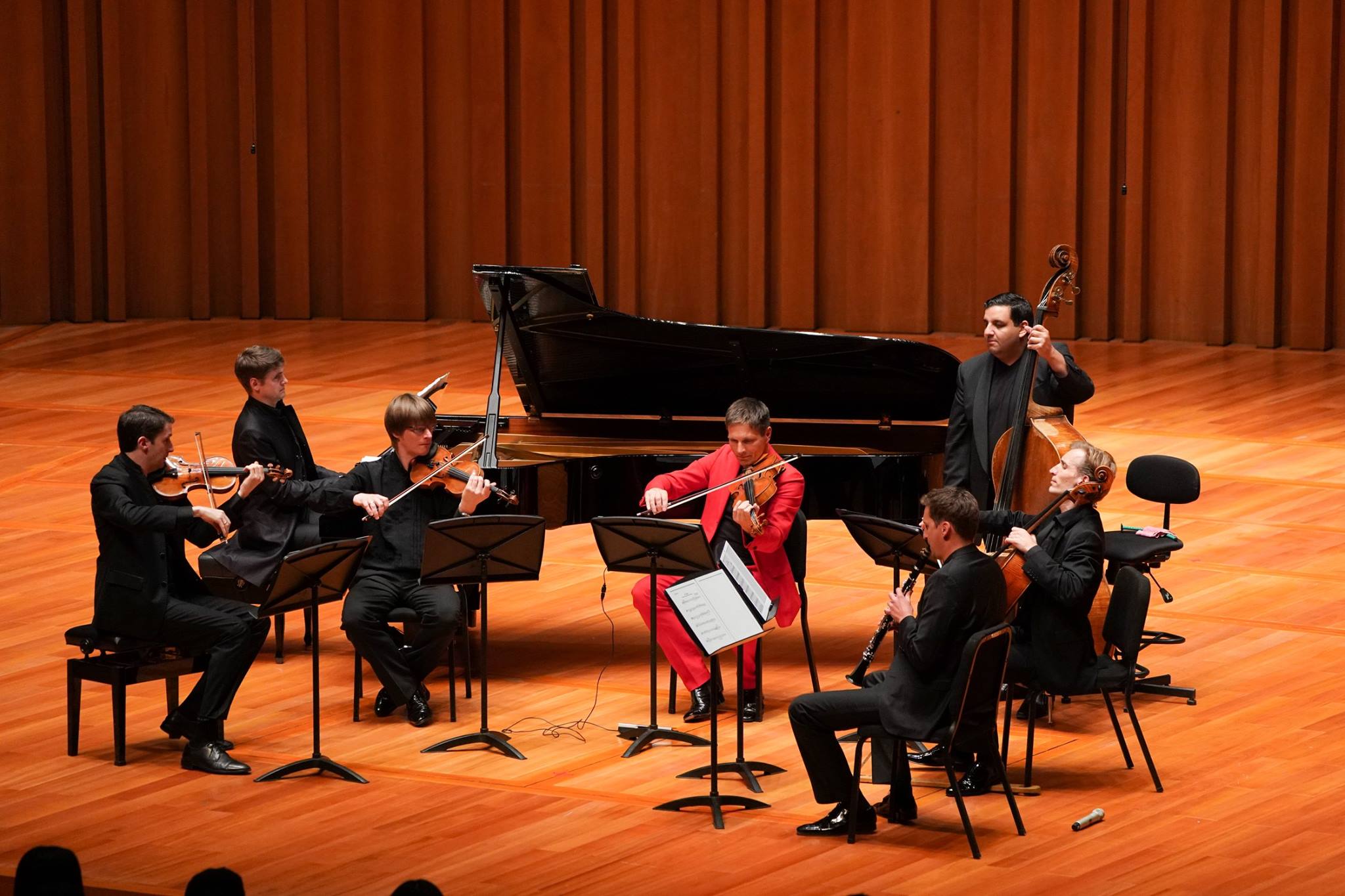
(L-R) Noah Bendix Balgley, Christoph Traxler, Sebastian Gürtler, Thilo Fechner, Ödön Rácz, Stephan Koncz, and Daniel Ottensamer. Philharmonix live at Beijing’s National Centre for the Performing Arts in May 2018. (via)
What’s it been like to play for audiences in rural European locations?
SK It’s been quite an experience to play on top of the mountains. As you can imagine, the altitude means the weather is quite spontaneous, so winds came up yesterday just before our outdoor concert, and the clouds were looking quite menacing, so we decided to go inside, to a brewery.
NBB It was also at the top of the mountain, but we had room for a good 400 or 500 people.
SK It was very packed and intimate atmosphere.
… which suits the music you’re doing.
SK It does. It felt wonderful in fact, to be near the audience, and they felt close to us,
NBB … and that wouldn’t have happened outside.
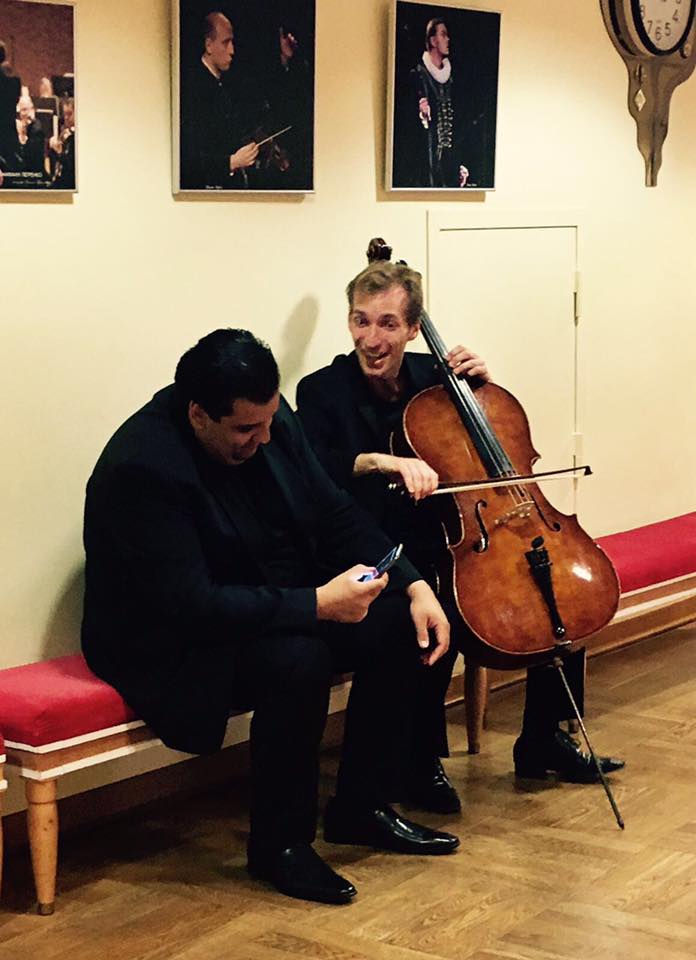
Ödön Rácz and Stephan Koncz. (via)
That intimacy seems especially important to what you do in Philharmonix. How did you choose the repertoire? I hear a lot of the Hungarian music that was part of my childhood.
SK We are seven people — two half-Hungarians, myself and Daniel Ottensamer the clarinettist, and bass player Ödön Rácz, he’s fully Hungarian. So it’s like automatism — we want to play Hungarian folk and gypsy music. Actually, that was our first big influence at the beginning. We came together in order to play the music we can’t usually play in the high and mighty concert halls with our orchestras.
NBB We were just driving from our last concert to our stop today in Austria, it was a couple hours of driving, and we had Ödön putting on various CDs, it was this huge mix — that’s the epitome of what we’re about — and we were saying, “Oh, we can use that sound for a new track!” or, “We can take this riff!” or “We should use that bass line!” We’re always looking for some sort of musical spark that gets us excited about playing something together and that’s the nice thing: we get to decide what we’re playing and how we’ll play it, because it’s our own arrangements.
SK We spend time with fantastic works by great composers yes, but obviously those composers were inspired by all the folk sounds and other contemporary works surrounding themselves back then. As with us, now we live in the times when we are surrounded by music; never in history has there been such access to music! So if there’s work being written and performed, and we’re inspired by it, we can’t just sit and play only our symphonic repertoire, or chamber or solos. The field of sounds is large, and we need to explore everywhere…
NBB … and not only as listeners, but as performers. We want to try our hand at a lot of different styles, even if we don’t know a lot about them. We try to dig in and make it as authentic as possible. If we’re playing a piece in the swing style or something that has more of a pop grove, things like that, we want to find the essence of what makes this music tick, and how we can get that across to an audience. It’s what we enjoy doing and what we do when we get together.
It feels as if because of this intimacy and immediacy, you have a lot more free reign for experimentation. How much improvisation you allow yourselves within this framework?
SK Quite a lot.
NBB At first when we’re starting with these, a lot of what we do is typical development: we’re working on a new program or new pieces to add to a program. Stefan and Sebastian will come to rehearsal with a new piece — or the skeleton of a new piece — and we start rehearsing, to see what happens. People throw in ideas or other references to other pieces, so that’s part of the process to come up with our end product, but it’s never really an “end product,” because in the concert we still want to surprise each other, and throw in different things. The best part is how audiences react to that, because if somebody tries something interesting we‘ll enjoy that, and that joy comes across to the audience. It’s really spontaneous, and happening the moment.
SK And that mood affects the programming. We’ll play two sets and sometimes it’s just made up onstage, depending on how the audience reacts to certain thing we do. We’ll see the audience needs certain tunes or a piece to wake up with or whatever, so we adjust accordingly. The program is not so written in stone. Of course since we are trained musicians we expect a certain level nevertheless, but it’s a relaxed thing, it’s hard to describe. It’s far more exhausting to play a Philharmonix concert than normal, but, I never feel more relaxed onstage than with these guys as well.
NBB We feel audiences can really tell the difference in whatever style. If we have a program and (musicians) are tired and going through the motions, in many cases, whether it’s classical or something a little more broad, an audience responds to that — they know if that sound is really together or not. And we feel it too. So it’s important we can always try to deliver energy from our end.

Noah Bendix-Balgley performs with Philharmonix in Beijing in 2018. (via)
Whose idea was it to start this project?
SK I mean it’s a mixture of friends from the sandbox, We’ve all know each other for a long time now; Daniel and I go back to playing together as kids. In the beginning I think one of the first ideas came from Ödön — he wanted to play his Hungarian folk music and couldn’t – he’s with the Vienna Phil. Like, what can you do about that folk music there? Well, you need an ensemble. so we went from that point. And now, for almost three years, we are doing this set-up, and it’s a wonderful voyage.
The international mix of members you have, and style you play in, harkens back to another era in some ways, It’s modern but it’s so old-school. How conscious were of that as you formalized this collective?
NBB We’re very conscious about trying to get the atmosphere and the sound of the particular style. So we have a piece on the first album, “Rose Room”, inspired by Benny Goodman and Artie Shaw, and that sound, the bass and everything, is us trying to get to the essence of, “What was that sound?” We try to find that. Or with Hungarian gypsy things, like the Brahms Hungarian Dance arrangements, we usually defer to Ödön for that; he has very specific knowledge about to play the rhythm and approach notes and timing, all those things to make it authentic. So maybe that’s what you’re hearing, that sense of an old sound, going back to the roots and core of the style in that piece. For other pieces, ones with more of a pop influence, we go for something more modern and mechanical sometimes. We think about that and really do work on that when we rehearse. We do the same thing when we’re playing the core classical rep too, you try to play a different sound for Mozart than you do for Beethoven, than you do for Shostakovich. With the rep we do as Philharmonix, we can go much further and try out some really crazy things with our instruments.
SK And the performances with Philharmonix have largely, speaking only for myself, really influenced my core classical repertoire.
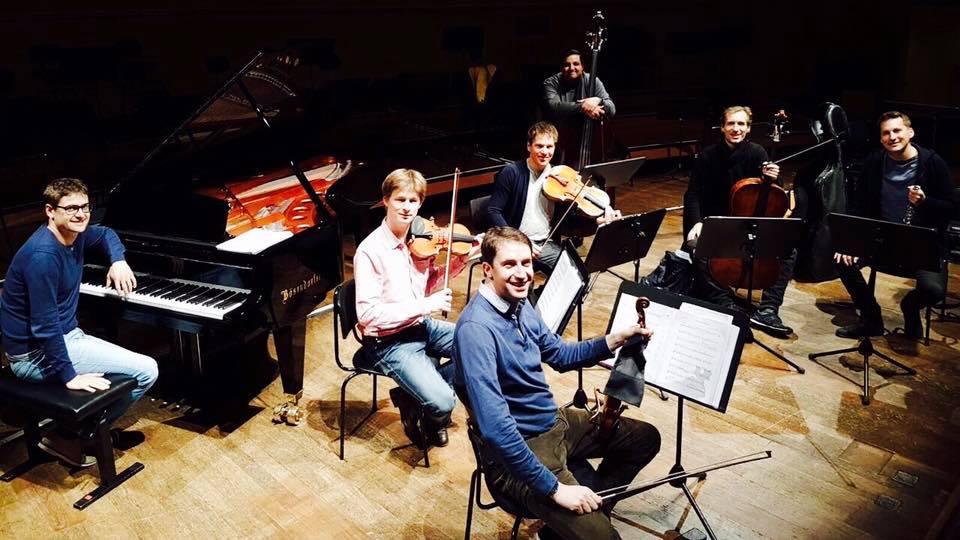
Rehearsing before a performance at Wiener Konzerthaus in 2018. (via)
I was just going to ask you how this this project has influenced how you do your day job.
SK Both show us how to perform onstage, because we feel that once we do our research, so to speak, on the roots of folk for instance, once we’ve done this for Philharmonix purposes, then this knowledge translates to most classical core performances, because classical composers made references to the pop music of their time, much more so than we allow ourselves to acknowledge now. It’s good and much freer because somehow if you have done the research, you can base your freedom on knowledge; you feel free because you have figured out what the base is for all of this.
You’ve given yourself permission to explore the creative things that aren’t always encouraged within some realms of the classical world.
SK It gives more confidence onstage. Beethoven himself was one of the most famous improvisers of his time, the way he composed sometimes was free improvisations, so as a performer if you hear, “Okay, he improvised this bit, and the root of it is that” then you more comfortable onstage.
NBB For performers and for audiences it’s in that moment, rather than being exactly prescribed how you take that timing, vibrato, things like that — it’s in that moment you can be more free.
SK The holy grail for performing classical is really to make it sound as if it’s been written in the moment. That’s the grail as a performer. We’re not the composers but we need to represent it as though it was just now composed to the audience. So people see it and feel it immediately, As a performer of classical music and for Philharmonix that’s what we do there: we try to create on the spot. This is the daily bread of every jazz musician, but for us, it’s a new stick in the game.
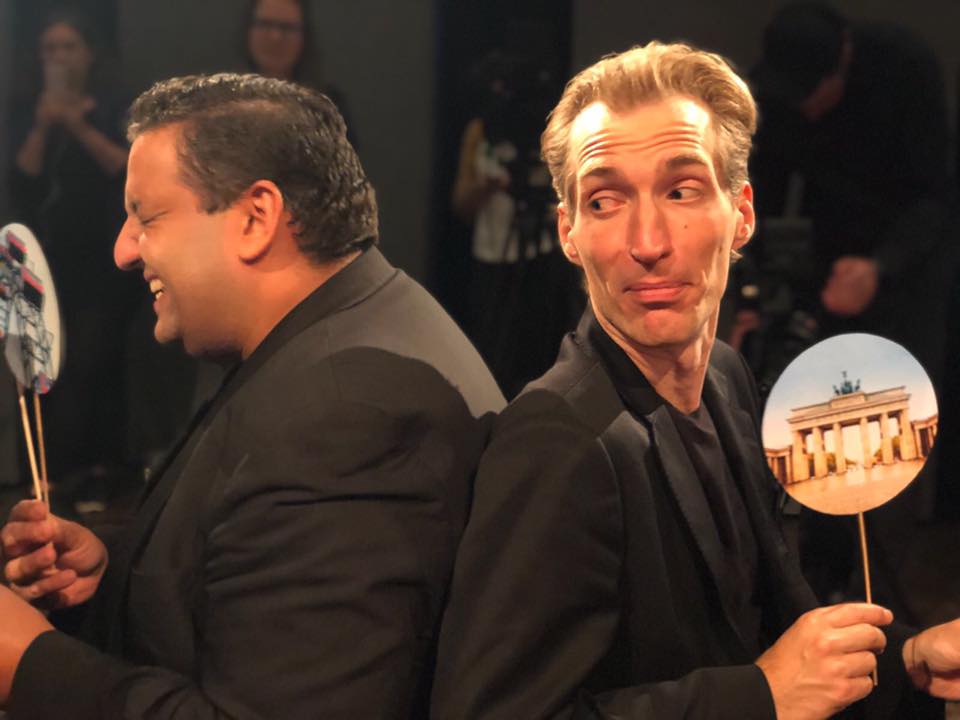
Ödön Rácz and Stephan Koncz (via)
Would you ever consider adding a cimbalom?
SK Today as we did our field research on our car ride, we listened to various types of folk, and the cimbalom is one of the heroes of Hungarian music, honestly.
NB We try to recreate other instruments with what we have, so for example Sebastian likes to imitate muted trumpet, and sometimes we do a thing where you hit a string with the wood of the bow to imitate a dulcimer, or imitate the pan flute sound. All these things broaden what our instruments can actually do.
SK I’m still thinking about the cimbalom and how we get that, though; to me, the sound is extremely unique…
It has that very identifiable ping. There’s nothing quite like it.
SK Totally! With the new album where our instruments imitate pan flutes, we tried to get the colour right, but it’s kind of old-Europe sounds with that cimbalom, and there isn’t the intention for this old Europe. It happens like this in Hungarian music, because the gypsies nowadays, they still play this romantic Brahms sound, in a way, but it’s just one of our styles that we like to be active in.
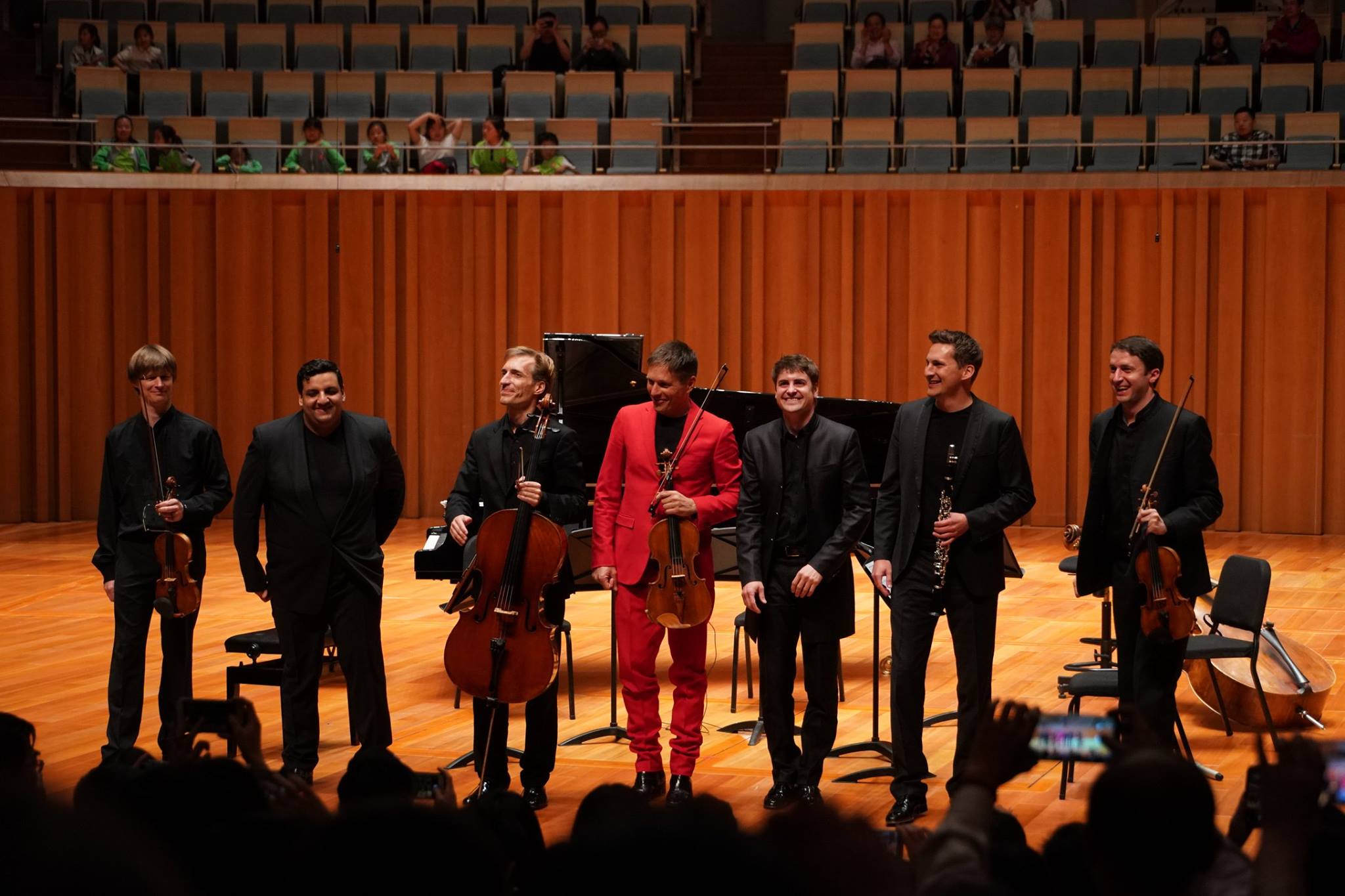
Performing in Beijing in 2018. (via)
What do your Berlin Philharmonic colleagues think about this exploration?
NBB They might be a little jealous, I don’t know! One of the nice things about being in the Berlin Philharmonic, in addition to being an incredible orchestra and having this really urgent and vibrant approach, is that we have time to pursue other projects, Stephan and I are doing a lot of concerts in Philharnonix and other projects as well, but our colleagues are also doing things, like playing Baroque music in their free time, or tango, or jazz, or conducting and composing, so there’s a very open attitude to people going out individually to pursue creative activities themselves, with the thought that, “Okay, you go on a tour with your Baroque tour for two weeks; when you come back to the orchestra it will be invigorating, you’ll be refreshed and inspired.” What you do within the orchestra after that will be positively influenced by that activity. It’s very good the whole orchestra has this. A lot of musicians in the Berlin Philharmonic are very serious about other musical projects outside of the orchestra that nicely complement what we do in it.
SK The funny thing about the Berlin Philharmonic is that, whatever colleagues do on the side, they do it intensely. People do everything in an extreme way, and I think it makes the music better in the end.

